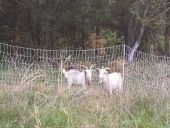
 1
1





"Study books and observe nature; if they do not agree, throw away the books." ~ William A. Albrecht
 3
3




I want to be 15 again …so I can ruin my life differently.
 6
6




"The only thing...more expensive than education is ignorance."~Ben Franklin. "We can easily forgive a child who is afraid of the dark; the real tragedy of life is when men are afraid of the light." ~ Plato
 7
7




It's never too late to start! I retired to homestead on the slopes of Mauna Loa, an active volcano. I relate snippets of my endeavor on my blog : www.kaufarmer.blogspot.com
 5
5




"The only thing...more expensive than education is ignorance."~Ben Franklin. "We can easily forgive a child who is afraid of the dark; the real tragedy of life is when men are afraid of the light." ~ Plato
 4
4




Carla Burke wrote: If you get the goats, be prepared to lose your hearts.
"Study books and observe nature; if they do not agree, throw away the books." ~ William A. Albrecht
 6
6




The best gardening course: https://gardenmastercourse.com
Permies.com FAQ
 7
7




James Freyr wrote:
-how many goats do/did you keep on what size plot of land? Anything you would change?
-do you believe three to be a sufficient number to satisfy the social needs of goats?
-how much milk have you taken from a doe to leave enough for the kid(s) also and avoid bottle feeding
-do you think 4 foot tall welded wire fence is adequate or is 5 foot tall necessary?
-how far do you think a 50lb 2-twine square bale of hay will go for three adults?
Our Destination is Our Legacy
www.peacefulvalleyfold.com
 5
5




 4
4




"The only thing...more expensive than education is ignorance."~Ben Franklin. "We can easily forgive a child who is afraid of the dark; the real tragedy of life is when men are afraid of the light." ~ Plato
 6
6




 6
6





 During the summer it's maybe a bale a week. Like mentioned before, goats act like they are allergic to rain.
During the summer it's maybe a bale a week. Like mentioned before, goats act like they are allergic to rain.
 3
3




 4
4




"Study books and observe nature; if they do not agree, throw away the books." ~ William A. Albrecht
 5
5




"The only thing...more expensive than education is ignorance."~Ben Franklin. "We can easily forgive a child who is afraid of the dark; the real tragedy of life is when men are afraid of the light." ~ Plato
 3
3




Carla Burke wrote: be prepared to lose your hearts.
"Study books and observe nature; if they do not agree, throw away the books." ~ William A. Albrecht
 2
2




Where my chicks have roamed no grass grows!
 2
2




With appropriate microbes, minerals and organic matter, there is no need for pesticides or herbicides.

| I agree. Here's the link: http://stoves2.com |


